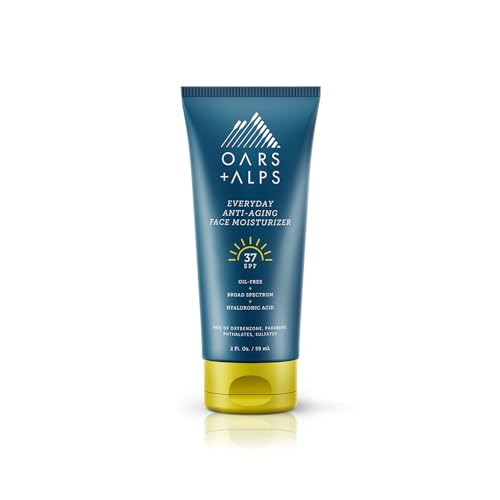
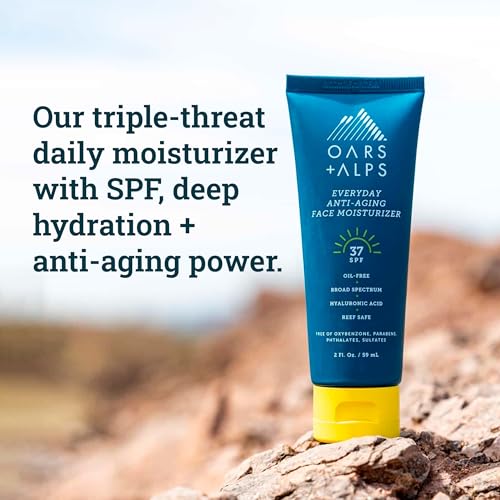
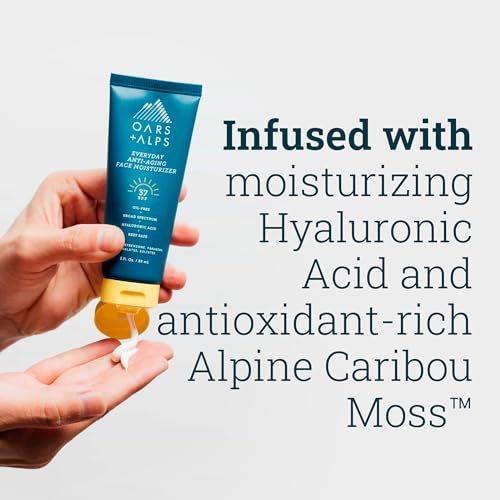
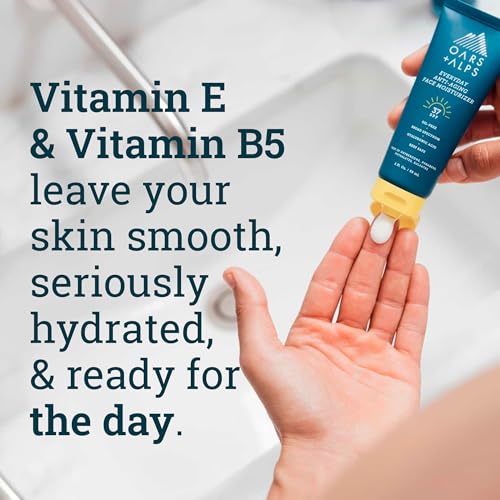
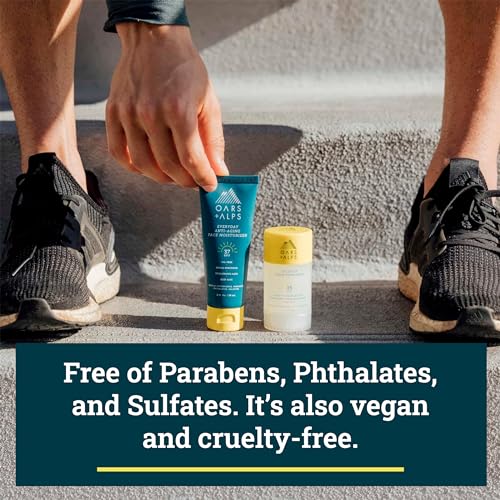
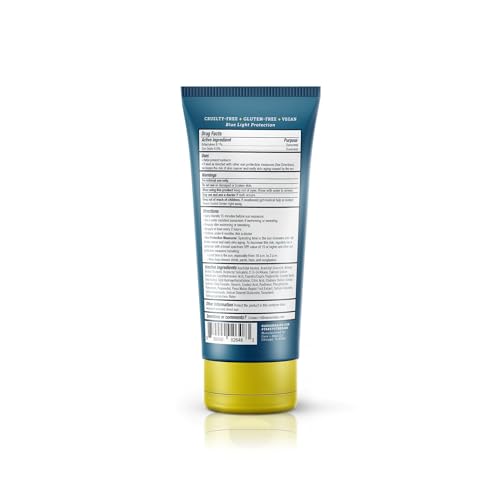
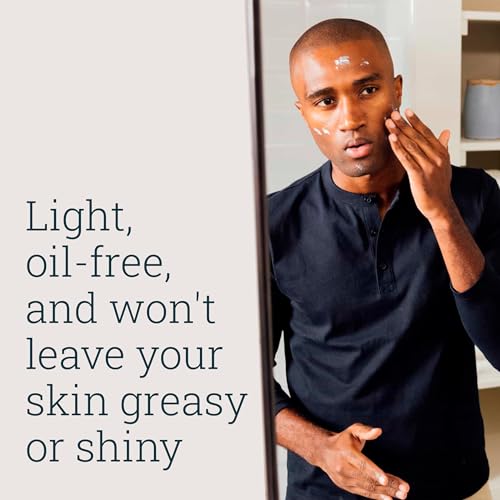
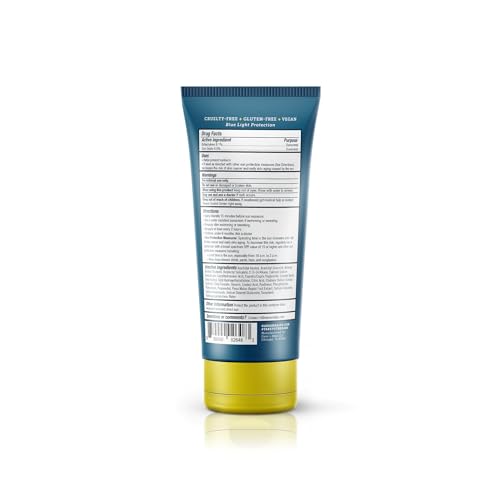
Oars + Alps Moisturizer - Daily Hydration & SPF 37 Protection, Vegan, Oil-Free - 2 Fl Oz


Bisabolol
Medium RiskBisabolol is a scent ingredient naturally occurring in various plants, particularly in chamomile. It is primarily used in cosmetics for its fragrance and potential skin-soothing properties, contributing to the overall sensory experience of personal care products.
Sustai Insights
Bisabolol offers functional benefits as a fragrance component and may provide skin-soothing effects. It is generally recognized for its low carcinogenic risk and low developmental toxicity, though moderate concerns exist regarding allergy potential. Bisabolol is also subject to certain restrictions in verified products. Environmental impacts are minimal, but it should be used with caution in sensitive populations. Overall, it poses a medium risk level based on current scientific understanding.
Zinc Oxide(sunscreen Grade)
Medium RiskZinc oxide (sunscreen grade) is a mineral compound often used in sunscreens for its ability to provide broad-spectrum UV protection. It is micronized to improve its cosmetic feel and skin application, making it suitable for various formulations, including those designed for sensitive skin.
Sustai Insights
Zinc oxide offers effective UV protection and is generally considered safe for topical use; however, it has moderate concerns related to allergies and potential skin absorption. Regulatory bodies have noted use restrictions, particularly in specific formulations. While its environmental impact is relatively low, concerns about enhanced skin absorption warrant caution. Overall, the risk level is assessed as medium, and users are advised to follow safe application practices. Alternatives such as titanium dioxide may provide similar benefits with potentially lower allergenic risks.
Citric Acid
Medium RiskCitric acid is an alpha hydroxy acid used in personal care products primarily for its role as a pH adjuster and natural preservative. It occurs naturally in citrus fruits and is commonly utilized in various formulations for its chelating properties and mild exfoliation benefits.
Sustai Insights
Citric acid offers functional benefits as an effective preservative and pH stabilizer, contributing to product longevity and stability. It is biodegradable and derived from renewable sources. Health risks are low, with minimal concerns regarding carcinogenicity, allergies, and reproductive toxicity. However, moderate use restrictions exist due to potential irritation at high concentrations. Environmental risks are limited, as citric acid is not known to accumulate in ecosystems. Regulatory agencies have no significant advisories against its use. Overall, it is assessed as a medium-risk ingredient, with safe usage practices recommended and alternatives available.
Butyloctyl Salicylate
Medium RiskButyloctyl salicylate is a synthetic compound often used in cosmetic formulations for its ability to enhance skin absorption and stability of products. It primarily functions as a UV filter, providing protection against harmful sun rays in various personal care items.
Sustai Insights
Butyloctyl salicylate offers functional benefits as a UV filter and enhances skin absorption in formulations. However, it is associated with moderate usage restrictions due to potential health risks such as skin irritation and concerns regarding enhanced absorption. Environmental considerations include its pollutant potential, though it is not highly bioaccumulative. Regulatory bodies have placed limitations on its use in certain products, reflecting a medium risk assessment overall. Safe usage practices are advisable, and alternatives like natural UV filters may be considered.
Arachidyl Glucoside
Medium RiskArachidyl glucoside is a product obtained by the glycosylation of arachidyl alcohol, commonly used as an emulsifier and surfactant in cosmetic formulations. It helps to stabilize and enhance the texture of products, improving spreadability and skin feel.
Sustai Insights
Arachidyl glucoside offers functional benefits as an emulsifier in formulations, enhancing product stability. It is considered to have low health risks related to cancer, allergies, and reproductive toxicity. However, concerns about endocrine disruption have been noted, warranting cautious use. Environmentally, it poses low bioaccumulation risk and is not classified as a significant pollutant. Regulatory assessments indicate no major restrictions. Overall, the risk level is categorized as medium, suggesting careful consideration in formulation and use, with potential alternatives available for enhanced safety.
C13 14 Alkane
Low RiskC13-14 alkane is a mixture of alkanes with carbon chain lengths ranging from 13 to 14. It is commonly used in personal care and cosmetic products as a solvent, emollient, or conditioning agent due to its ability to provide a smooth feel and enhance product texture.
Sustai Insights
C13-14 alkane serves as an effective emulsifier and skin conditioning agent, contributing to the overall texture and application of cosmetic products. It is considered low risk for health concerns, including carcinogenicity and allergic reactions. Environmentally, it poses minimal risks, with no significant bioaccumulation or pollution potential noted. Regulatory assessments indicate no restrictions, reflecting its safety profile in various regions. Despite its functional benefits, users should practice standard safety measures. Alternatives like plant-derived emollients may offer similar benefits with enhanced sustainability. Overall, it is classified as low risk.
Caprylyl Glycol
Low RiskCaprylyl glycol (1,2-octanediol) is a multifunctional cosmetic ingredient primarily used as a skin-conditioning agent and preservative. It is derived from caprylic acid, a fatty acid found in coconut oil, and is commonly included in personal care products for its moisturizing properties.
Sustai Insights
Caprylyl glycol offers functional benefits such as acting as an effective humectant and preservative, enhancing skin hydration and product stability. It is considered to have low health risks, with no significant concerns regarding carcinogenicity, allergies, or reproductive toxicity. Environmentally, it poses minimal risks, being non-bioaccumulative and not linked to pollution. Regulatory assessments affirm its safety, with no major advisories against its use. Overall, the ingredient is assessed to have a low risk, making it a suitable choice in cosmetic formulations.
Pyrus Malus (Apple) Fruit Extract
Low RiskPyrus malus (apple) fruit extract is derived from the fruit of the apple tree and is commonly used in cosmetic formulations for its nourishing properties and potential skin benefits.
Sustai Insights
Pyrus malus (apple) fruit extract offers functional benefits such as antioxidant properties and skin conditioning. It is considered low risk for health concerns, including cancer, allergies, and reproductive toxicity. Environmentally, it poses minimal risks, being non-pollutant and non-bioaccumulative. Regulatory bodies do not impose significant restrictions on its use. Overall, it is deemed low risk, making it a suitable ingredient in cosmetic products. Safe usage practices should still be observed, and alternatives may include other fruit extracts for similar benefits.
Water
Low RiskWater is a clear, colorless liquid essential for various biological processes. It serves as a solvent in formulations, facilitating the dissolution of other ingredients and enhancing product texture and application. Additionally, water plays a crucial role in hydration and is a key component in many cosmetic and personal care products.
Sustai Insights
Water is an effective solvent and hydrator, contributing to the texture and efficacy of formulations. It is biodegradable and generally regarded as safe, with low concerns regarding carcinogenicity, allergies, and reproductive toxicity. However, excessive water usage can lead to environmental concerns, particularly regarding resource depletion. Regulatory bodies do not impose restrictions on water use in cosmetics. Overall, the risks associated with water are low, making it a safe and essential ingredient.
Ethyl Ferulate
Low RiskEthyl ferulate is an ester of ferulic acid, primarily used for its antioxidant properties in cosmetic and skincare formulations. It is known for its ability to stabilize and enhance product efficacy, often serving as a preservative and UV protectant in various applications.
Sustai Insights
Ethyl ferulate offers functional benefits as an effective antioxidant and preservative, enhancing product stability. It is considered low risk regarding health concerns, with minimal associations to carcinogenicity, allergies, or reproductive toxicity. Environmentally, it poses low pollutant potential and is not bioaccumulative. Regulatory bodies do not impose restrictions on its use. Safe usage practices should be adhered to, while alternatives, such as natural antioxidants, could be considered for sustainability. Overall, ethyl ferulate is assessed to have low risk.
Linoleic Acid
Low RiskLinoleic acid is a naturally occurring unsaturated fatty acid, primarily found in plant oils such as sunflower, safflower, and corn oil. It plays a crucial role in various biological processes, including cellular membrane structure and function, as well as serving as a precursor for other essential fatty acids.
Sustai Insights
Linoleic acid is recognized for its functional benefits, including supporting skin health and maintaining cellular integrity, while being biodegradable and derived from renewable sources. Health risks are minimal, with low concerns regarding carcinogenicity, allergies, and reproductive toxicity. Environmentally, it poses low risks, with no significant pollutant potential. Regulatory bodies have not imposed major restrictions on linoleic acid, confirming its safety for use. Overall, linoleic acid presents a low risk profile, making it a viable ingredient with sustainable advantages.
Diethylhexyl 2,6 Naphthalate
Low RiskDiethylhexyl 2,6 naphthalate is a phthalate compound primarily used as a plasticizer in various products, enhancing flexibility and durability. It is commonly found in materials such as plastics, adhesives, and coatings, contributing to product performance.
Sustai Insights
Diethylhexyl 2,6 naphthalate serves as an effective plasticizer, improving the workability and longevity of materials. While it has low concerns regarding cancer, allergies, and reproductive toxicity, there are moderate risks related to cumulative exposure from multiple sources. Environmentally, it is not classified as bioaccumulative or a significant pollutant. Regulatory bodies currently do not impose restrictions on its use. Overall, the risk level is considered low, and safer alternatives may include other biodegradable plasticizers.
Hydroxyethylcellulose
Low RiskHydroxyethylcellulose is a modified cellulose polymer used primarily as a thickening agent and stabilizer in various cosmetic and personal care products. It is soluble in water and helps to improve the texture and viscosity of formulations, enhancing their usability and performance.
Sustai Insights
Hydroxyethylcellulose offers functional benefits such as effective thickening and stabilization in formulations, contributing to product texture. It is generally considered low-risk in terms of health, with minimal concerns regarding carcinogenicity, allergens, or reproductive toxicity. Environmentally, it poses low risks and is not known to be bioaccumulative. Regulatory bodies have not imposed significant restrictions on its use. Safe practices include adhering to recommended concentrations, and while alternatives exist, hydroxyethylcellulose remains a low-risk ingredient overall.
Sodium Arachidate
Low RiskSodium arachidate is a sodium salt derived from arachidic acid, primarily used as an emulsifier and thickening agent in cosmetic and personal care products. It contributes to the stability and texture of formulations, enhancing the overall product performance.
Sustai Insights
Sodium arachidate offers functional benefits as an emulsifier, effectively stabilizing formulations and improving texture. It is considered low risk regarding health concerns, with no significant evidence of carcinogenicity, allergenic potential, or reproductive toxicity. Environmentally, it is not recognized as a pollutant or bioaccumulative. Regulatory bodies do not impose restrictions on its use, affirming its safety profile. Overall, it presents a low risk, making it a suitable ingredient in cosmetic applications. For alternatives, options like stearic acid or other plant-derived emulsifiers may be considered.
Sodium Gluconate
Low RiskSodium gluconate is a sodium salt of gluconic acid, commonly used as a chelating agent in various personal care products. It functions primarily to bind metal ions, enhancing product stability and efficacy. Additionally, it may serve as a moisturizer and skin conditioning agent.
Sustai Insights
Sodium gluconate is valued for its functional benefits, including effective chelation and moisture retention, contributing positively to product performance. It is considered low risk concerning health impacts, with minimal concerns regarding carcinogenicity, allergies, or reproductive toxicity. Environmental assessments indicate low pollutant potential and minimal bioaccumulation. Regulatory bodies have not imposed significant restrictions. Safe usage practices are advised, particularly regarding enhanced skin absorption. Overall, sodium gluconate presents a low risk profile, making it a viable choice in personal care formulations.
Sodium Acetylhyaluronate
Low RiskSodium acetylhyaluronate is a sodium salt derivative of hyaluronic acid, commonly used in cosmetic formulations for its hydrating properties. It functions primarily as a humectant, attracting moisture to the skin and helping to maintain hydration levels in various personal care products.
Sustai Insights
Sodium acetylhyaluronate is recognized for its effective moisture-retaining properties, enhancing skin hydration and improving product texture. It has low health risks, with negligible concerns regarding carcinogenicity, allergies, or reproductive toxicity. Environmentally, it poses minimal risks and is not associated with significant pollution or bioaccumulation. Regulatory assessments indicate no current restrictions. Overall, it is considered low risk, making it a favorable ingredient in cosmetic formulations.
Behenyl Alcohol
Low RiskBehensyl alcohol is a saturated fatty alcohol obtained from the seeds of the Ben oil plant. It is primarily used as an emollient, emulsifier, and thickening agent in various cosmetic and personal care formulations.
Sustai Insights
Behensyl alcohol offers functional benefits such as improving product texture and stability. It is considered to have low health risks, with minimal concerns regarding carcinogenicity, allergies, and reproductive toxicity. Environmentally, it poses low risks as a pollutant and is not bioaccumulative. Regulatory bodies have not issued significant warnings. Overall, it is assessed to have a low risk profile. Safe usage involves adhering to recommended concentrations, and potential alternatives include other fatty alcohols that may provide similar benefits.
Tocopherol, D Alpha
Low RiskTocopherol, specifically d-alpha tocopherol, is a naturally occurring form of Vitamin E. It is commonly used in cosmetic and personal care products primarily for its antioxidant properties, helping to protect formulations from oxidation and extend shelf life.
Sustai Insights
D-alpha tocopherol provides effective antioxidant benefits, contributing to product stability. It is sustainably sourced and generally regarded as safe, with low concerns regarding carcinogenicity, allergies, and reproductive toxicity. However, there are minor concerns about endocrine disruption. Regulatory bodies have not imposed significant restrictions, indicating low overall risk. Recommended usage practices include adhering to established safe concentration thresholds. Alternatives, such as other forms of Vitamin E or plant-based antioxidants, may also be considered.
Erythritol
Low RiskErythritol is a sugar alcohol used primarily as a low-calorie sweetener in various food and beverage products. It occurs naturally in some fruits and fermented foods. Erythritol provides sweetness without significant calories or raising blood glucose levels, making it a popular alternative to traditional sugars.
Sustai Insights
Erythritol offers functional benefits as a sweetener with low caloric content, providing a suitable option for sugar reduction. It is considered safe with low concerns regarding carcinogenicity, allergies, and reproductive toxicity. Environmentally, it is not recognized as a significant pollutant nor does it bioaccumulate. Regulatory status is favorable, with no current restrictions. Overall, the ingredient presents a low risk, making it a viable option for consumers seeking healthier alternatives.
Propanediol
Low RiskPropanediol is a glycol compound commonly used in cosmetic and personal care products as a solvent, humectant, and skin-conditioning agent. It serves to enhance the texture and moisture retention of formulations, contributing to overall product efficacy.
Sustai Insights
Propanediol offers functional benefits such as effective moisture retention and improved product application. It is considered low-risk in terms of health concerns, with minimal associations with carcinogenicity, allergies, or reproductive toxicity. Environmentally, it has low pollutant potential and is not bioaccumulative. Regulatory bodies have not placed restrictions on its use. Despite concerns regarding enhanced skin absorption and potential endocrine disruption, the overall assessment indicates low risk. Safe usage practices should be followed, and alternatives like glycerin or other plant-based humectants can be considered.
Phytosterols
Low RiskPhytosterols are a mixture of sterols obtained from plant sources, primarily functioning as lipid ingredients in cosmetic formulations. They are known for their emollient properties, contributing to skin hydration and overall texture enhancement in various products.
Sustai Insights
Phytosterols offer functional benefits such as skin barrier support and hydration. They are associated with low health risks, including negligible concerns regarding carcinogenicity, allergies, and reproductive toxicity. Environmentally, phytosterols are not considered pollutants or bioaccumulative. They are not currently restricted by regulatory bodies, suggesting a low overall risk. Safe usage practices involve incorporating them in appropriate concentrations in formulations, with no widely recognized safer substitutes.
Calcium Sodium Borosilicate
Low RiskCalcium sodium borosilicate is a glass-type material used primarily as a filler and thickener in various cosmetic and personal care products. It enhances texture and provides a smooth application, contributing to the overall aesthetic of formulations.
Sustai Insights
Calcium sodium borosilicate offers functional benefits as a texturizing agent and is often considered low risk regarding health concerns, including carcinogenicity and allergenic potential. While it is generally safe, enhanced skin absorption may be a consideration. Regulatory agencies have noted low usage restrictions, although verified products cannot contain certain levels. Environmentally, it poses minimal risks as it is not classified as a significant pollutant or bioaccumulative. Overall, the ingredient is assessed as low risk, with no significant adverse impacts reported, making it a suitable choice in formulations.
Phospholipids
Low RiskPhospholipids are naturally occurring complex lipids that are essential components of cell membranes. They play a key role in maintaining cellular structure and function, and are commonly used in cosmetic formulations for their emulsifying and moisturizing properties.
Sustai Insights
Phospholipids offer functional benefits such as enhancing skin hydration and stability in formulations. They are generally recognized as safe, with low concerns for cancer, allergies, or reproductive toxicity. Environmentally, they are biodegradable and sustainably sourced, posing minimal ecological risks. Regulatory bodies have not indicated significant hazards, resulting in a low overall risk assessment. For safety, it is advisable to monitor individual sensitivities, and alternatives like natural oils may be explored for similar benefits.
Vegetarian Glycerin
Low RiskVegetarian glycerin, also known as glycerol, is a colorless, odorless, and viscous liquid derived from plant sources. It is primarily used as a humectant, solvent, and emollient in various personal care products, helping to retain moisture and improve texture.
Sustai Insights
Vegetarian glycerin offers functional benefits as an effective humectant, promoting hydration and skin smoothness. It is biodegradable and typically sustainably sourced. Health risks associated with glycerin are low, with no significant concerns for carcinogenicity, allergens, or reproductive toxicity. Environmental risks are minimal, and it is not subject to major regulatory warnings. Overall, the risk level for this ingredient is low, making it a safe choice in formulations. Safe usage practices include ensuring proper concentrations in products, and alternatives such as propylene glycol exist but may have differing properties.
Panthenol, D
Low RiskPanthenol, also known as provitamin B5, is a humectant commonly used in cosmetic and personal care products. It functions primarily as a moisturizer, enhancing skin hydration and improving the appearance of hair by imparting shine and softness.
Sustai Insights
Panthenol is effective in retaining moisture, thus providing functional benefits for skin and hair care products. It is generally recognized as safe, with low concerns regarding carcinogenicity, allergies, and developmental toxicity. However, potential cumulative exposure from multiple sources exists. Environmental risks are minimal, and it is not bioaccumulative. Regulatory bodies have not issued significant warnings; therefore, the overall risk level is assessed as low. For optimal use, it is recommended to follow product guidelines, and alternatives such as glycerin may also be considered for moisturizing effects.
Triethoxycaprylylsilane
Low RiskTriethoxycaprylylsilane is a silicon-based ingredient primarily used as a binder in cosmetic formulations. It helps in improving product texture and stability, facilitating the blending of various components in formulations.
Sustai Insights
Triethoxycaprylylsilane offers functional benefits as an effective binder, enhancing the stability and texture of cosmetic products. It has low concerns related to cancer, allergies, and reproductive toxicity. While there are low risks of irritation and endocrine disruption, regulatory bodies have verified its safety for use. Environmental risks appear minimal, with no significant bioaccumulation or pollutant potential. Overall, the ingredient is assessed as low risk. For safer alternatives, manufacturers may consider other silicone alternatives that provide similar functional benefits.
Caprylic Triglyceride
Low RiskCaprylic triglyceride is an ester derived from coconut oil and glycerin, commonly used in cosmetic formulations as an emollient, stabilizer, and skin-conditioning agent. It helps to improve the texture and spreadability of products while providing a lightweight, non-greasy feel.
Sustai Insights
Caprylic triglyceride offers functional benefits such as enhanced skin moisturization and improved formulation stability. It is generally regarded as safe, with low concerns regarding carcinogenicity, allergenic potential, and reproductive toxicity. Environmental impact is minimal, with no significant pollutant or bioaccumulative properties identified. Regulatory bodies have not issued warnings or restrictions. Overall, the risk level is low, making it a suitable ingredient in cosmetic products. Safe usage practices include adhering to recommended concentrations, and while there are alternatives, caprylic triglyceride remains a reliable choice.
Sodium Stearoyl Glutamate
Low RiskSodium stearoyl glutamate is a surfactant and emulsifier commonly used in cosmetic formulations. It helps stabilize mixtures of oil and water, enhancing the texture and feel of products. This ingredient is derived from glutamic acid and stearic acid, and it is typically found in skin care and hair care products.
Sustai Insights
Sodium stearoyl glutamate offers functional benefits as an emulsifier, effectively improving product consistency. It is considered to have low health risks regarding carcinogenicity, allergies, and reproductive toxicity. Environmental impact is minimal, with no significant pollutant or bioaccumulation concerns noted. Regulatory bodies do not impose serious restrictions on its use. Overall, it is assessed as low risk, making it a suitable ingredient in cosmetic formulations. Safe usage practices should be followed, and alternatives are available for those seeking different emulsifying agents.
Cetyl Alcohol
Low RiskCetyl alcohol is a long-chain organic alcohol commonly used in cosmetic formulations. It serves as an emollient, emulsifier, and thickening agent, enhancing the texture and stability of products. Cetyl alcohol is derived from natural sources, such as coconut or palm oil, and is often included in creams, lotions, and hair conditioners.
Sustai Insights
Cetyl alcohol offers functional benefits as an emollient and emulsifier, improving product texture and stability. It is biodegradable and sourced from renewable materials, contributing to sustainability. Health risks are minimal, with low concerns for carcinogenicity, allergies, or reproductive toxicity. Environmental impact is also low, with no significant pollutant or bioaccumulation potential. Regulatory bodies have not placed restrictions on its use, indicating a favorable safety profile. Overall, cetyl alcohol is assessed as low risk, and safe usage practices include ensuring proper formulation concentrations.
C13 14 Alkane
Low RiskC13-14 alkane is a mixture of alkanes with carbon chain lengths ranging from 13 to 14. It is commonly used in personal care and cosmetic products as a solvent, emollient, or conditioning agent due to its ability to provide a smooth feel and enhance product texture.
Sustai Insights
C13-14 alkane serves as an effective emulsifier and skin conditioning agent, contributing to the overall texture and application of cosmetic products. It is considered low risk for health concerns, including carcinogenicity and allergic reactions. Environmentally, it poses minimal risks, with no significant bioaccumulation or pollution potential noted. Regulatory assessments indicate no restrictions, reflecting its safety profile in various regions. Despite its functional benefits, users should practice standard safety measures. Alternatives like plant-derived emollients may offer similar benefits with enhanced sustainability. Overall, it is classified as low risk.
Caprylyl Glycol
Low RiskCaprylyl glycol (1,2-octanediol) is a multifunctional cosmetic ingredient primarily used as a skin-conditioning agent and preservative. It is derived from caprylic acid, a fatty acid found in coconut oil, and is commonly included in personal care products for its moisturizing properties.
Sustai Insights
Caprylyl glycol offers functional benefits such as acting as an effective humectant and preservative, enhancing skin hydration and product stability. It is considered to have low health risks, with no significant concerns regarding carcinogenicity, allergies, or reproductive toxicity. Environmentally, it poses minimal risks, being non-bioaccumulative and not linked to pollution. Regulatory assessments affirm its safety, with no major advisories against its use. Overall, the ingredient is assessed to have a low risk, making it a suitable choice in cosmetic formulations.
Pyrus Malus (Apple) Fruit Extract
Low RiskPyrus malus (apple) fruit extract is derived from the fruit of the apple tree and is commonly used in cosmetic formulations for its nourishing properties and potential skin benefits.
Sustai Insights
Pyrus malus (apple) fruit extract offers functional benefits such as antioxidant properties and skin conditioning. It is considered low risk for health concerns, including cancer, allergies, and reproductive toxicity. Environmentally, it poses minimal risks, being non-pollutant and non-bioaccumulative. Regulatory bodies do not impose significant restrictions on its use. Overall, it is deemed low risk, making it a suitable ingredient in cosmetic products. Safe usage practices should still be observed, and alternatives may include other fruit extracts for similar benefits.
Water
Low RiskWater is a clear, colorless liquid essential for various biological processes. It serves as a solvent in formulations, facilitating the dissolution of other ingredients and enhancing product texture and application. Additionally, water plays a crucial role in hydration and is a key component in many cosmetic and personal care products.
Sustai Insights
Water is an effective solvent and hydrator, contributing to the texture and efficacy of formulations. It is biodegradable and generally regarded as safe, with low concerns regarding carcinogenicity, allergies, and reproductive toxicity. However, excessive water usage can lead to environmental concerns, particularly regarding resource depletion. Regulatory bodies do not impose restrictions on water use in cosmetics. Overall, the risks associated with water are low, making it a safe and essential ingredient.
Bisabolol
Medium RiskBisabolol is a scent ingredient naturally occurring in various plants, particularly in chamomile. It is primarily used in cosmetics for its fragrance and potential skin-soothing properties, contributing to the overall sensory experience of personal care products.
Sustai Insights
Bisabolol offers functional benefits as a fragrance component and may provide skin-soothing effects. It is generally recognized for its low carcinogenic risk and low developmental toxicity, though moderate concerns exist regarding allergy potential. Bisabolol is also subject to certain restrictions in verified products. Environmental impacts are minimal, but it should be used with caution in sensitive populations. Overall, it poses a medium risk level based on current scientific understanding.
Ethyl Ferulate
Low RiskEthyl ferulate is an ester of ferulic acid, primarily used for its antioxidant properties in cosmetic and skincare formulations. It is known for its ability to stabilize and enhance product efficacy, often serving as a preservative and UV protectant in various applications.
Sustai Insights
Ethyl ferulate offers functional benefits as an effective antioxidant and preservative, enhancing product stability. It is considered low risk regarding health concerns, with minimal associations to carcinogenicity, allergies, or reproductive toxicity. Environmentally, it poses low pollutant potential and is not bioaccumulative. Regulatory bodies do not impose restrictions on its use. Safe usage practices should be adhered to, while alternatives, such as natural antioxidants, could be considered for sustainability. Overall, ethyl ferulate is assessed to have low risk.
Zinc Oxide(sunscreen Grade)
Medium RiskZinc oxide (sunscreen grade) is a mineral compound often used in sunscreens for its ability to provide broad-spectrum UV protection. It is micronized to improve its cosmetic feel and skin application, making it suitable for various formulations, including those designed for sensitive skin.
Sustai Insights
Zinc oxide offers effective UV protection and is generally considered safe for topical use; however, it has moderate concerns related to allergies and potential skin absorption. Regulatory bodies have noted use restrictions, particularly in specific formulations. While its environmental impact is relatively low, concerns about enhanced skin absorption warrant caution. Overall, the risk level is assessed as medium, and users are advised to follow safe application practices. Alternatives such as titanium dioxide may provide similar benefits with potentially lower allergenic risks.
Linoleic Acid
Low RiskLinoleic acid is a naturally occurring unsaturated fatty acid, primarily found in plant oils such as sunflower, safflower, and corn oil. It plays a crucial role in various biological processes, including cellular membrane structure and function, as well as serving as a precursor for other essential fatty acids.
Sustai Insights
Linoleic acid is recognized for its functional benefits, including supporting skin health and maintaining cellular integrity, while being biodegradable and derived from renewable sources. Health risks are minimal, with low concerns regarding carcinogenicity, allergies, and reproductive toxicity. Environmentally, it poses low risks, with no significant pollutant potential. Regulatory bodies have not imposed major restrictions on linoleic acid, confirming its safety for use. Overall, linoleic acid presents a low risk profile, making it a viable ingredient with sustainable advantages.
Diethylhexyl 2,6 Naphthalate
Low RiskDiethylhexyl 2,6 naphthalate is a phthalate compound primarily used as a plasticizer in various products, enhancing flexibility and durability. It is commonly found in materials such as plastics, adhesives, and coatings, contributing to product performance.
Sustai Insights
Diethylhexyl 2,6 naphthalate serves as an effective plasticizer, improving the workability and longevity of materials. While it has low concerns regarding cancer, allergies, and reproductive toxicity, there are moderate risks related to cumulative exposure from multiple sources. Environmentally, it is not classified as bioaccumulative or a significant pollutant. Regulatory bodies currently do not impose restrictions on its use. Overall, the risk level is considered low, and safer alternatives may include other biodegradable plasticizers.
Hydroxyethylcellulose
Low RiskHydroxyethylcellulose is a modified cellulose polymer used primarily as a thickening agent and stabilizer in various cosmetic and personal care products. It is soluble in water and helps to improve the texture and viscosity of formulations, enhancing their usability and performance.
Sustai Insights
Hydroxyethylcellulose offers functional benefits such as effective thickening and stabilization in formulations, contributing to product texture. It is generally considered low-risk in terms of health, with minimal concerns regarding carcinogenicity, allergens, or reproductive toxicity. Environmentally, it poses low risks and is not known to be bioaccumulative. Regulatory bodies have not imposed significant restrictions on its use. Safe practices include adhering to recommended concentrations, and while alternatives exist, hydroxyethylcellulose remains a low-risk ingredient overall.
Sodium Arachidate
Low RiskSodium arachidate is a sodium salt derived from arachidic acid, primarily used as an emulsifier and thickening agent in cosmetic and personal care products. It contributes to the stability and texture of formulations, enhancing the overall product performance.
Sustai Insights
Sodium arachidate offers functional benefits as an emulsifier, effectively stabilizing formulations and improving texture. It is considered low risk regarding health concerns, with no significant evidence of carcinogenicity, allergenic potential, or reproductive toxicity. Environmentally, it is not recognized as a pollutant or bioaccumulative. Regulatory bodies do not impose restrictions on its use, affirming its safety profile. Overall, it presents a low risk, making it a suitable ingredient in cosmetic applications. For alternatives, options like stearic acid or other plant-derived emulsifiers may be considered.
Citric Acid
Medium RiskCitric acid is an alpha hydroxy acid used in personal care products primarily for its role as a pH adjuster and natural preservative. It occurs naturally in citrus fruits and is commonly utilized in various formulations for its chelating properties and mild exfoliation benefits.
Sustai Insights
Citric acid offers functional benefits as an effective preservative and pH stabilizer, contributing to product longevity and stability. It is biodegradable and derived from renewable sources. Health risks are low, with minimal concerns regarding carcinogenicity, allergies, and reproductive toxicity. However, moderate use restrictions exist due to potential irritation at high concentrations. Environmental risks are limited, as citric acid is not known to accumulate in ecosystems. Regulatory agencies have no significant advisories against its use. Overall, it is assessed as a medium-risk ingredient, with safe usage practices recommended and alternatives available.
Sodium Gluconate
Low RiskSodium gluconate is a sodium salt of gluconic acid, commonly used as a chelating agent in various personal care products. It functions primarily to bind metal ions, enhancing product stability and efficacy. Additionally, it may serve as a moisturizer and skin conditioning agent.
Sustai Insights
Sodium gluconate is valued for its functional benefits, including effective chelation and moisture retention, contributing positively to product performance. It is considered low risk concerning health impacts, with minimal concerns regarding carcinogenicity, allergies, or reproductive toxicity. Environmental assessments indicate low pollutant potential and minimal bioaccumulation. Regulatory bodies have not imposed significant restrictions. Safe usage practices are advised, particularly regarding enhanced skin absorption. Overall, sodium gluconate presents a low risk profile, making it a viable choice in personal care formulations.
Butyloctyl Salicylate
Medium RiskButyloctyl salicylate is a synthetic compound often used in cosmetic formulations for its ability to enhance skin absorption and stability of products. It primarily functions as a UV filter, providing protection against harmful sun rays in various personal care items.
Sustai Insights
Butyloctyl salicylate offers functional benefits as a UV filter and enhances skin absorption in formulations. However, it is associated with moderate usage restrictions due to potential health risks such as skin irritation and concerns regarding enhanced absorption. Environmental considerations include its pollutant potential, though it is not highly bioaccumulative. Regulatory bodies have placed limitations on its use in certain products, reflecting a medium risk assessment overall. Safe usage practices are advisable, and alternatives like natural UV filters may be considered.
Sodium Acetylhyaluronate
Low RiskSodium acetylhyaluronate is a sodium salt derivative of hyaluronic acid, commonly used in cosmetic formulations for its hydrating properties. It functions primarily as a humectant, attracting moisture to the skin and helping to maintain hydration levels in various personal care products.
Sustai Insights
Sodium acetylhyaluronate is recognized for its effective moisture-retaining properties, enhancing skin hydration and improving product texture. It has low health risks, with negligible concerns regarding carcinogenicity, allergies, or reproductive toxicity. Environmentally, it poses minimal risks and is not associated with significant pollution or bioaccumulation. Regulatory assessments indicate no current restrictions. Overall, it is considered low risk, making it a favorable ingredient in cosmetic formulations.
Behenyl Alcohol
Low RiskBehensyl alcohol is a saturated fatty alcohol obtained from the seeds of the Ben oil plant. It is primarily used as an emollient, emulsifier, and thickening agent in various cosmetic and personal care formulations.
Sustai Insights
Behensyl alcohol offers functional benefits such as improving product texture and stability. It is considered to have low health risks, with minimal concerns regarding carcinogenicity, allergies, and reproductive toxicity. Environmentally, it poses low risks as a pollutant and is not bioaccumulative. Regulatory bodies have not issued significant warnings. Overall, it is assessed to have a low risk profile. Safe usage involves adhering to recommended concentrations, and potential alternatives include other fatty alcohols that may provide similar benefits.
Tocopherol, D Alpha
Low RiskTocopherol, specifically d-alpha tocopherol, is a naturally occurring form of Vitamin E. It is commonly used in cosmetic and personal care products primarily for its antioxidant properties, helping to protect formulations from oxidation and extend shelf life.
Sustai Insights
D-alpha tocopherol provides effective antioxidant benefits, contributing to product stability. It is sustainably sourced and generally regarded as safe, with low concerns regarding carcinogenicity, allergies, and reproductive toxicity. However, there are minor concerns about endocrine disruption. Regulatory bodies have not imposed significant restrictions, indicating low overall risk. Recommended usage practices include adhering to established safe concentration thresholds. Alternatives, such as other forms of Vitamin E or plant-based antioxidants, may also be considered.
Erythritol
Low RiskErythritol is a sugar alcohol used primarily as a low-calorie sweetener in various food and beverage products. It occurs naturally in some fruits and fermented foods. Erythritol provides sweetness without significant calories or raising blood glucose levels, making it a popular alternative to traditional sugars.
Sustai Insights
Erythritol offers functional benefits as a sweetener with low caloric content, providing a suitable option for sugar reduction. It is considered safe with low concerns regarding carcinogenicity, allergies, and reproductive toxicity. Environmentally, it is not recognized as a significant pollutant nor does it bioaccumulate. Regulatory status is favorable, with no current restrictions. Overall, the ingredient presents a low risk, making it a viable option for consumers seeking healthier alternatives.
Propanediol
Low RiskPropanediol is a glycol compound commonly used in cosmetic and personal care products as a solvent, humectant, and skin-conditioning agent. It serves to enhance the texture and moisture retention of formulations, contributing to overall product efficacy.
Sustai Insights
Propanediol offers functional benefits such as effective moisture retention and improved product application. It is considered low-risk in terms of health concerns, with minimal associations with carcinogenicity, allergies, or reproductive toxicity. Environmentally, it has low pollutant potential and is not bioaccumulative. Regulatory bodies have not placed restrictions on its use. Despite concerns regarding enhanced skin absorption and potential endocrine disruption, the overall assessment indicates low risk. Safe usage practices should be followed, and alternatives like glycerin or other plant-based humectants can be considered.
Phytosterols
Low RiskPhytosterols are a mixture of sterols obtained from plant sources, primarily functioning as lipid ingredients in cosmetic formulations. They are known for their emollient properties, contributing to skin hydration and overall texture enhancement in various products.
Sustai Insights
Phytosterols offer functional benefits such as skin barrier support and hydration. They are associated with low health risks, including negligible concerns regarding carcinogenicity, allergies, and reproductive toxicity. Environmentally, phytosterols are not considered pollutants or bioaccumulative. They are not currently restricted by regulatory bodies, suggesting a low overall risk. Safe usage practices involve incorporating them in appropriate concentrations in formulations, with no widely recognized safer substitutes.
Arachidyl Glucoside
Medium RiskArachidyl glucoside is a product obtained by the glycosylation of arachidyl alcohol, commonly used as an emulsifier and surfactant in cosmetic formulations. It helps to stabilize and enhance the texture of products, improving spreadability and skin feel.
Sustai Insights
Arachidyl glucoside offers functional benefits as an emulsifier in formulations, enhancing product stability. It is considered to have low health risks related to cancer, allergies, and reproductive toxicity. However, concerns about endocrine disruption have been noted, warranting cautious use. Environmentally, it poses low bioaccumulation risk and is not classified as a significant pollutant. Regulatory assessments indicate no major restrictions. Overall, the risk level is categorized as medium, suggesting careful consideration in formulation and use, with potential alternatives available for enhanced safety.
Calcium Sodium Borosilicate
Low RiskCalcium sodium borosilicate is a glass-type material used primarily as a filler and thickener in various cosmetic and personal care products. It enhances texture and provides a smooth application, contributing to the overall aesthetic of formulations.
Sustai Insights
Calcium sodium borosilicate offers functional benefits as a texturizing agent and is often considered low risk regarding health concerns, including carcinogenicity and allergenic potential. While it is generally safe, enhanced skin absorption may be a consideration. Regulatory agencies have noted low usage restrictions, although verified products cannot contain certain levels. Environmentally, it poses minimal risks as it is not classified as a significant pollutant or bioaccumulative. Overall, the ingredient is assessed as low risk, with no significant adverse impacts reported, making it a suitable choice in formulations.
Phospholipids
Low RiskPhospholipids are naturally occurring complex lipids that are essential components of cell membranes. They play a key role in maintaining cellular structure and function, and are commonly used in cosmetic formulations for their emulsifying and moisturizing properties.
Sustai Insights
Phospholipids offer functional benefits such as enhancing skin hydration and stability in formulations. They are generally recognized as safe, with low concerns for cancer, allergies, or reproductive toxicity. Environmentally, they are biodegradable and sustainably sourced, posing minimal ecological risks. Regulatory bodies have not indicated significant hazards, resulting in a low overall risk assessment. For safety, it is advisable to monitor individual sensitivities, and alternatives like natural oils may be explored for similar benefits.
Vegetarian Glycerin
Low RiskVegetarian glycerin, also known as glycerol, is a colorless, odorless, and viscous liquid derived from plant sources. It is primarily used as a humectant, solvent, and emollient in various personal care products, helping to retain moisture and improve texture.
Sustai Insights
Vegetarian glycerin offers functional benefits as an effective humectant, promoting hydration and skin smoothness. It is biodegradable and typically sustainably sourced. Health risks associated with glycerin are low, with no significant concerns for carcinogenicity, allergens, or reproductive toxicity. Environmental risks are minimal, and it is not subject to major regulatory warnings. Overall, the risk level for this ingredient is low, making it a safe choice in formulations. Safe usage practices include ensuring proper concentrations in products, and alternatives such as propylene glycol exist but may have differing properties.
Panthenol, D
Low RiskPanthenol, also known as provitamin B5, is a humectant commonly used in cosmetic and personal care products. It functions primarily as a moisturizer, enhancing skin hydration and improving the appearance of hair by imparting shine and softness.
Sustai Insights
Panthenol is effective in retaining moisture, thus providing functional benefits for skin and hair care products. It is generally recognized as safe, with low concerns regarding carcinogenicity, allergies, and developmental toxicity. However, potential cumulative exposure from multiple sources exists. Environmental risks are minimal, and it is not bioaccumulative. Regulatory bodies have not issued significant warnings; therefore, the overall risk level is assessed as low. For optimal use, it is recommended to follow product guidelines, and alternatives such as glycerin may also be considered for moisturizing effects.
Triethoxycaprylylsilane
Low RiskTriethoxycaprylylsilane is a silicon-based ingredient primarily used as a binder in cosmetic formulations. It helps in improving product texture and stability, facilitating the blending of various components in formulations.
Sustai Insights
Triethoxycaprylylsilane offers functional benefits as an effective binder, enhancing the stability and texture of cosmetic products. It has low concerns related to cancer, allergies, and reproductive toxicity. While there are low risks of irritation and endocrine disruption, regulatory bodies have verified its safety for use. Environmental risks appear minimal, with no significant bioaccumulation or pollutant potential. Overall, the ingredient is assessed as low risk. For safer alternatives, manufacturers may consider other silicone alternatives that provide similar functional benefits.
Caprylic Triglyceride
Low RiskCaprylic triglyceride is an ester derived from coconut oil and glycerin, commonly used in cosmetic formulations as an emollient, stabilizer, and skin-conditioning agent. It helps to improve the texture and spreadability of products while providing a lightweight, non-greasy feel.
Sustai Insights
Caprylic triglyceride offers functional benefits such as enhanced skin moisturization and improved formulation stability. It is generally regarded as safe, with low concerns regarding carcinogenicity, allergenic potential, and reproductive toxicity. Environmental impact is minimal, with no significant pollutant or bioaccumulative properties identified. Regulatory bodies have not issued warnings or restrictions. Overall, the risk level is low, making it a suitable ingredient in cosmetic products. Safe usage practices include adhering to recommended concentrations, and while there are alternatives, caprylic triglyceride remains a reliable choice.
Sodium Stearoyl Glutamate
Low RiskSodium stearoyl glutamate is a surfactant and emulsifier commonly used in cosmetic formulations. It helps stabilize mixtures of oil and water, enhancing the texture and feel of products. This ingredient is derived from glutamic acid and stearic acid, and it is typically found in skin care and hair care products.
Sustai Insights
Sodium stearoyl glutamate offers functional benefits as an emulsifier, effectively improving product consistency. It is considered to have low health risks regarding carcinogenicity, allergies, and reproductive toxicity. Environmental impact is minimal, with no significant pollutant or bioaccumulation concerns noted. Regulatory bodies do not impose serious restrictions on its use. Overall, it is assessed as low risk, making it a suitable ingredient in cosmetic formulations. Safe usage practices should be followed, and alternatives are available for those seeking different emulsifying agents.
Cetyl Alcohol
Low RiskCetyl alcohol is a long-chain organic alcohol commonly used in cosmetic formulations. It serves as an emollient, emulsifier, and thickening agent, enhancing the texture and stability of products. Cetyl alcohol is derived from natural sources, such as coconut or palm oil, and is often included in creams, lotions, and hair conditioners.
Sustai Insights
Cetyl alcohol offers functional benefits as an emollient and emulsifier, improving product texture and stability. It is biodegradable and sourced from renewable materials, contributing to sustainability. Health risks are minimal, with low concerns for carcinogenicity, allergies, or reproductive toxicity. Environmental impact is also low, with no significant pollutant or bioaccumulation potential. Regulatory bodies have not placed restrictions on its use, indicating a favorable safety profile. Overall, cetyl alcohol is assessed as low risk, and safe usage practices include ensuring proper formulation concentrations.
Experience the ultimate skin care solution with Oars + Alps SPF 37 Sunscreen and Everyday Anti-Aging Face Moisturizer. This all-in-one moisturizer hydrates, protects against harmful UV rays, and combats signs of aging, making it an essential part of your daily routine.
- Triple Action Formula: This moisturizer provides hydration, sun protection, and anti-aging benefits in one step, simplifying your skincare regimen.
- Broad Spectrum SPF 37: Shield your skin from UVA and UVB rays daily, eliminating the need for an additional sunscreen.
- Lightweight & Oil-Free: Enjoy intense moisture without the greasy feel, as this non-comedogenic formula absorbs quickly, leaving your skin fresh and matte.
- Nourishing Ingredients: Infused with Hyaluronic Acid, Vitamin E, and Vitamin B5, this product hydrates and nourishes, helping to reduce fine lines and improve skin texture.
- Eco-Friendly & Safe: Vegan, cruelty-free, and free from parabens, phthalates, and sulfates, this moisturizer is gentle on both skin and the environment, promoting a healthier world.
Subscribe & Save with Sustai
- Best Price Guarantee: Always enjoy the lowest prices on sustainable home essentials.
- No Surprises: We’ll notify you before shipping. No hidden fees, ever.
- You’re in Charge: Change, pause, or cancel your subscription anytime with ease.
- Eco-Friendly Deliveries: Our grouped shipments mean less packaging and lower emissions.
Join us on a sustainable journey. Special offers for a limited time! Prices and promotions may change.
Recommended Products
Experience the ultimate skin care solution with Oars + Alps SPF 37 Sunscreen and Everyday Anti-Aging Face Moisturizer. This all-in-one moisturizer hydrates, protects against harmful UV rays, and combats signs of aging, making it an essential part of your daily routine.
- Triple Action Formula: This moisturizer provides hydration, sun protection, and anti-aging benefits in one step, simplifying your skincare regimen.
- Broad Spectrum SPF 37: Shield your skin from UVA and UVB rays daily, eliminating the need for an additional sunscreen.
- Lightweight & Oil-Free: Enjoy intense moisture without the greasy feel, as this non-comedogenic formula absorbs quickly, leaving your skin fresh and matte.
- Nourishing Ingredients: Infused with Hyaluronic Acid, Vitamin E, and Vitamin B5, this product hydrates and nourishes, helping to reduce fine lines and improve skin texture.
- Eco-Friendly & Safe: Vegan, cruelty-free, and free from parabens, phthalates, and sulfates, this moisturizer is gentle on both skin and the environment, promoting a healthier world.

You can have at most 2 Sustainable Steals products in your cart
Customer Reviews
Customers’ View
Customers appreciate the effectiveness and eco-friendly formulation of the Oars + Alps SPF 37 Sunscreen and Anti-Aging Moisturizer. Many users highlight its lightweight, non-greasy texture, making it suitable for daily use without feeling heavy on the skin. One customer noted, "It absorbs beautifully without any residue," emphasizing its comfortable wear. The product's broad-spectrum sun protection and moisturizing properties are frequently commended, with users expressing satisfaction in maintaining skin hydration while being shielded from harmful rays. Additionally, the absence of parabens, phthalates, and sulfates aligns with the values of health-conscious consumers. Overall, customers find this product effective for protecting and nourishing their skin in an eco-friendly manner.
AI-generated from the text of customer reviewsThis product is rated 4.4 of 5.0 stars.
It has received 17 reviews.




